





December 7 - VIII
Justin woke up a little before 09:00, and Crystal woke up with an alarm at 09:00. While using an alarm is not really our idea of vacation, we were worried that our internal clocks were way off and that we needed to get them a little more in line with EU time, especially since some days we’d have to be up earlier anyway. Justin read an article about Hong Kong pilots and the onerous quarantine rules rules, and we had the epiphany that there were no Chinese tourists (or frankly any Southeast Asian tourists) anywhere so far this trip.
 |
 |
 |
 |
 |
 |
Our first stop of the day was the inside of the Cologne Cathedral, which opens to the public at 10:00. On the short walk to the Cathedral, we passed by a store that had some interesting Christmas gifts, such as a Santa on a circular track that goes down the chimney and out the front door, then back up (and down) again, and a different Santa singing “Last Christmas.” The inside of the Cathedral was more or less as expected, as after seeing dozens of churches in Europe the last few years, most of them - Sagrada Familia excepted - are pretty similar. While most of the stained glass windows had designs with pictures, some were just pixelated with different colors - we wondered if those were new, to distinguish from what was original. There was a woman talking on her phone in the church, which struck us as very odd; anything short of talking to a relative who was taking their last breath seems like it should be discussed outside.
 |
 |
 |
 |
 |
 |
After leaving the Cathedral, we went next door to the train station to buy tickets for our trip to Brussels tomorrow. Crystal ordered them just fine in German, but then we asked in English if there was anything we needed to know about construction or other issues, so as to avoid whatever plagued us coming from Trier. Thankfully the answer was no. After grabbing the tickets, we split up for a bit, with Justin climbing the South Tower of the Cathedral, 100 meters up to a viewing area. [The tower is 157 meters total.] Meanwhile Crystal went to a Starbucks to get a mug for her ever-growing collection of the City mugs, and then went to check out the Christmas Market next to the Cathedral to wait for Justin to descend. After he came down, we bought a cookie cutter that Crystal had seen, and took it and the mug back to the Airbnb to lighten our load.
 |
 |
 |
 |
 |
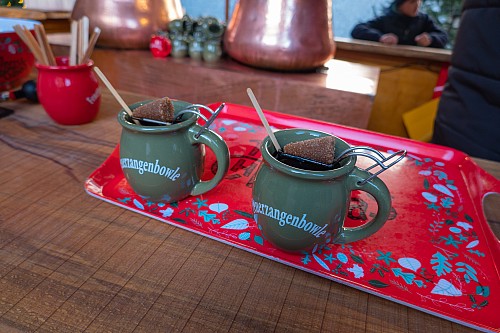 |
We went right back out and stopped at the Weinachtspyramide am Kölner Dom, a tiny market with one of the windmill-looking things we’d seen in Trier. At the market we got a hot drink called a Feuerzangenbowle that had a rum-soaked sugarloaf that drips into mulled wine below. They lit the sugarloaf just before giving us the drink. It was good, but as one can imagine, it ended up being quite sweet. To eat we got a currywurst (Justin) and Kasekrakauer (Crystal). The Kasekrakauer was the closest approximation of Bitzinger that Crystal has had so far. The currywurst was fine, not great.
 |
 |
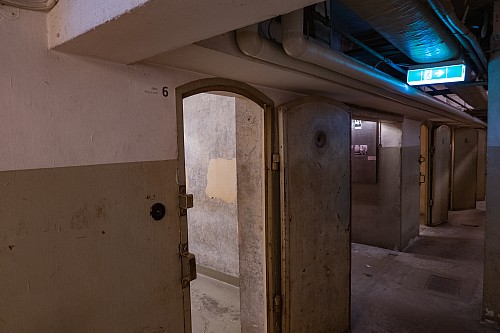 |
 |
After lunch we went to the El-De Haus, which is the former headquarters of the Gestapo in Cologne, and now a museum documenting the Third Reich. Despite 90% of the city being destroyed during World War II, the El-De Haus survived - go figure. The below-ground floors of the building had cells and torture rooms, and the museum was exactly as uplifting and cheery as one can imagine. It reminded us a bit of the House of Terror in Budapest. There were still inscriptions on the walls from the former prisoners, and many of the rooms had not been changed from 75 years ago, either.
 |
 |
After leaving the El-De Haus we slowly walked east, towards the river. It was sunny again, and there were some good views of the Cologne Cathedral from over by the El-De Haus. We passed by the Cathedral, and then walked across the bridge that we’d crossed on the train when we arrived in town. The bridge had thousands and thousands of locks from tourists on seemingly every inch of the bridge that could accommodate a lock. We wondered if the weight of all those locks significantly altered the strength of the bridge.
 |
 |
On the other side of the bridge, at one of the larger train stations (not the one we’d arrived at), we looked for the meeting place that Marcel provided us. Just as we started to look, a police vehicle drove up behind us and a couple armed policemen hopped out, ran past us, and ran up into the train station. That kind of threw us off, and perhaps because of that, or because we weren’t sure exactly what we were looking for (a DHL package drop or something like that), we couldn’t find it. We had the GPS for it on our phones, but the train station had multiple levels, and we weren’t sure which level to use. We were starting to get irked at what a dumb spot to meet to start a tour, but then Crystal found it, and before Justin could open his mouth to remark about the stupidity of the meeting spot, Marcel said “Hello, are you Justin?”
 |
 |
Whew, that was close. Marcel introduced himself, telling us how he’s lived in Cologne for years, and teaches history at one of the schools in town. He also explained why he chose this specific spot to meet. Apparently it was more or less the exact location that people during the war boarded trains to be shipped east out to the death camps. Indeed, there was a plaque on the wall that read (in German) “This point was the entrance to the Deutz-Tief train station, from here in 1940/41 more than 1500 Roma and since 1941 over 11,000 Jews were deported to concentration camps. In addition, the detainees from Deutz exhibition center were transported to and from here. Many people died on these stairs.” The building across the street was that Deutz exhibition center. Originally it was intended to be some sort of a business convention center, but it opened right before the Great Depression, never really got used for that purpose, and then became an interim concentration camp or prison for many. It is now a TV station headquarters. Anyway, we weren’t as irked at the meeting spot any more.
 |
 |
Marcel took us a little south, still on the east side of the river, to some of the original Roman gates from way back when. We never would’ve guessed that the brick remnants dated back that far. Cologne was founded in 38BC, a small town next to a Roman fort. The name Cologne comes from Colonia Claudia Ara Agrippinensium, which eventually became Colonia and then Cologne. Marcel told us there was an old bridge crossing the Rhine River, and that accordingly Cologne was one of the few cities in Europe that was built up on both sides of the river. In the same area, Marcel also took us to the oldest bar that wasn’t also a brewery, which happened to be closed this evening, perhaps because of Covid restrictions. Marcel indicated that there are no open container laws in Germany, that people are expected to just behave like adults. Fancy that.
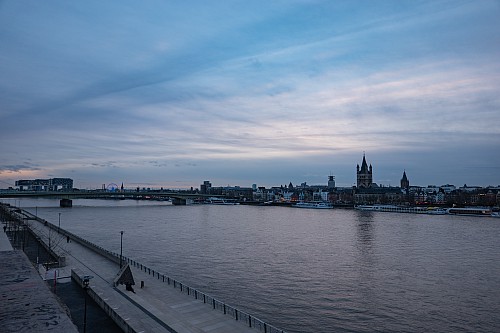 |
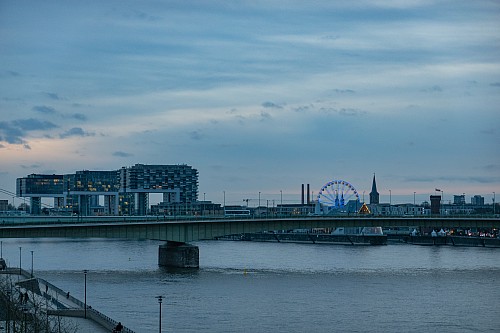 |
We next heard about how Cologne - theoretically - is the resting place of the Three Wise Men. As the story goes, Helena - the mother of Roman emperor Constantine the Great - traveled around the holy lands in 326 AD collecting religious relics. Included in that were the remains of the Magi, which she moved to the Hagia Sofia in Istanbul (then Constantinople). But 50-75 later, the Magi remains were moved to Milan. They stayed there for hundreds of years, but then the Holy Roman Emperor Frederick the Red moved the Magi remains to Cologne in 1164 AD, and they’ve been there ever since, and specifically in a gold sarcophagus since 1225 AD.
The Cologne Cathedral was built on top of this sarcophagus. Because the sarcophagus was/is so important in the Catholic religion, people in Cologne at some point realized that the Vatican needed Cologne more than Cologne needed the Vatican. The people of the city actually kicked the Archbishop of Cologne out of the city. [We can’t remember if this was a long time ago and/or more recent; apparently there was reason to do this recently, as the current archbishop was found by Pope Francis to have made “grave errors” regarding the ongoing sex abuse issues in the church.] Anyway, Cologne seems fairly liberal and independent-minded for such a theoretically religious city.
We walked back across the railway bridge, into Old Town. Marcel mentioned that the bridge was specifically designed to be heading straight for the Cathedral, as a sign to the Catholics that the government could do whatever they wanted, but the by-product of that is that the train tracks all curve just before getting to the station, which slows down every incoming and outgoing train. After getting back into Old Town, we went into Peters Brauhaus for some more beer. Marcel showed us that you put down your coaster first, and they’ll keep bringing you beer - and marking on the coaster - until you put the coaster on top of your (last) empty glass. He also told us why bartenders were generally rude; they didn’t want to be bartenders, they just wanted to make the beer, not sell it to customers.
 |
 |
The Ludwig Museum, right next to the Cathedral and the river, has one of the largest collections of Picassos anywhere in the world. We aren’t really into art (at all), so we hadn’t gone in, but we were aware it was there and it was famous. Marcel told us all the art was in Cologne because Cologne was the first city to commit to Ludwig (some rich guy), so they’d create a museum to house all his stuff after he died. We walked around Old Town and heard more stories and history, much of which we sadly can’t recall. We do remember Marcel telling us about Bavaria and its tenuous relationship with the rest of Germany. Apparently it dates back to when Bavaria first “joined” Germany - it was because Bavaria was broke and Germany was willing to take on its debts. We happened to walk right past our Airbnb, and to an empty square a street over, Haus Neuerburg, where the city refused to let Mr. Neuerburg build his house, and to this day there is still no house.
From there we walked further west into the shopping area we’d been a couple of times. Just before we got to the Neumarkt we went down into the metro. Marcel took us on the U-Bahn out to the (actual) Edelweiss Pirate spot. Normally he’d end a tour near the El-De Haus, but he knew we’d just been there, and that we were interested in the Edelweiss Pirates. After a couple stops we came up the stairs from one of the stops and the murals were right there. We decided we’d need to let Atlas Obscura know of the correct location. Marcel told us that the pirates had a complicated history, since it was unclear whether the pirates were true “resistance” or just young punks that happened to frustrate and irritate the nazis. The consensus now seems to be they were a true resistance group, even if their motives were not 100% admirable.
 |
 |
We took the U-Bahn back into town, and got off right near El-De Haus. In a parking garage right by there, we saw some Roman ruins right near the door; they were found when the car park was being built not too long ago. One wonders how much stuff is underground in Cologne that no one has found yet. Marcel took some photos of us in front of the Cathedral, and also pointed out that the object on the west side of the large plaza, near the top of the steps, is a life-size model of what sits on top of the cathedral spires. He mentioned that the Cologne Cathedral is not the tallest, as there is one in Ulm that is taller by 7 meters. This is why Justin had to walk down some stairs to go up the South Tower this morning, just so the stairs would be the tallest. Cologne now touts that the Cologne Cathedral is the tallest twin tower cathedral, a bit like how Malaysia touted the Petronas Towers in Kuala Lumpur as the tallest twin towers in the world. We asked if Sagrada Familia would eclipse the twin tower record, and Marcel said yes, if/when it is ever finished.
We wrapped up our time with Marcel at another brewery, Fruh. While we enjoyed our beers, we asked him about his other favorite cities. He said Rome (by a mile), Berlin, Lisbon, Amsterdam, Madrid (for food), and Bucharest (inexpensive). We invited him to stop by in San Diego when he visits, so that we can return the favor of showing him around. We went back to our Airbnb and charged some batteries, plus warmed up a bit. We tried to do the Eisstockschiessen (the curling game) at the Christmas Market, but all the lanes were already reserved. We lamented that we could’ve come this morning, but we would’ve missed Cologne Cathedral, and we figured that we can curl some other time. From there we headed over to the market with the windmills and got some orange-kirsch gluhwein, which was decent enough. All of the other patrons got really excited when “Last Christmas'' came on, and they sang along. We checked our phones looking for somewhere that had goulash, and Crystal noted that Fruh was one of the results. Since that looked good anyway, and was just down the street, we decided to go back there.
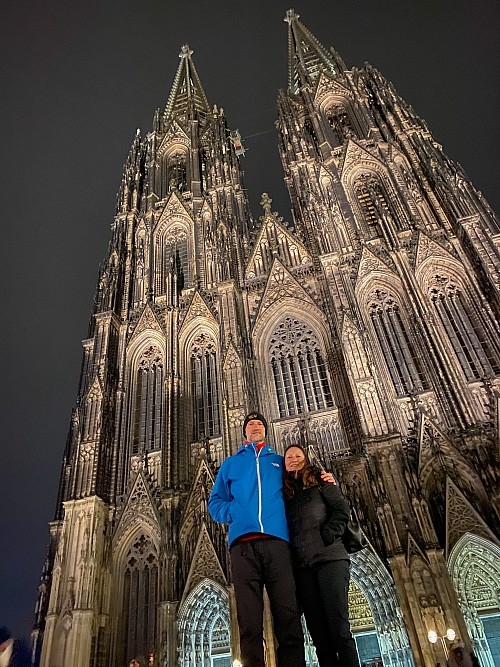 |
 |
We immediately put our new knowledge to use, putting out the coasters in front of us on our table, and sure enough, the waiter brought us two beers. He kept a running tab in roman numerals on Justin’s coaster. Crystal ordered spaetzle and a game stew. Justin got a “Brauhausteller” that had meatloaf, sausage, and a pork knuckle, plus potatoes and sauerkraut. Crystal really enjoyed the sauerkraut. One table near us was speaking Spanish, while another was speaking Italian (we think). The waiter seemed to like us, perhaps because he got a kick out of our rough German. He laughed out loud when he asked us if we wanted some schnapps and Crystal responded in German “after I’m done with the beer.” We also split some apfelstrudel when we got the schnapps. We finished a little before 23:00, and walked back home on very quiet streets. We tried in vain to catch up on the trip log before we forgot everything, but we probably forgot lots of stuff nonetheless.
| Previous Entry |